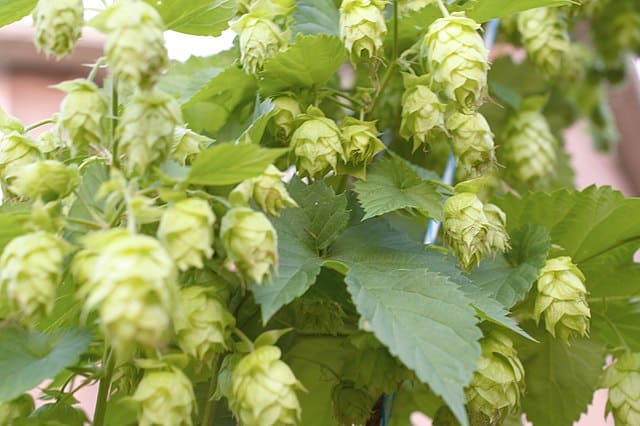It will come as no surprise that hops and cannabis are two of my favorite plants, organoleptically, medicinally, and scientifically. I am enchanted by the parallels between them. They are two genera (out of 11) in the Cannabaceae family, which boasts approximately 170 known species. On the phylogenetic tree, cannabis and hops are the closest relatives, and that closeness is exemplified by the soaring, ever entwining cannabis and craft beer industries. Hops have hash (lupulin), and many breweries, like Abjuration Brewing in Pittsburgh, New Image Brewing in Arvada, or SweetWater Brewing in Atlanta (just to name an ultra-limited few) are actively marketing their beers as containing terpenes, even though any brewery dry hopping their beers to the beautifully obscene levels that set the standard today could advertise the same! SweetWater put out a bewildering beer with B-Real of Cypress Hill (called Insane OG) that spooked a couple of squares in a bar I was in because they thought someone was openly flashing around some cannabis.
The parallels between these two remarkable plants extends into their medicinal potential as well. One story goes like this. When England colonized India, they attempted to transport their beer by boat. The beer became putrid, riddled with bacteria. Hops were added, and the beer survived the trip. The hops provided antimicrobial/antibacterial properties that extended shelf life and kept the beer fresh. This was no doubt due to terpenes/terpenoids like myrcene and linalool, alpha- and beta-acids like humulone and lupulone, flavonoids like xanthohumol, etc. Thus, the India Pale Ale was born!
These compounds and others within the hop plant like quercetin, resveratrol, or catechin can help us via their anti-inflammation, anticancer, and antioxidant wellness attributes. [1] Just like cousin cannabis, hops provide a wonderful biopharmacy. To concentrate these chemical constituents, scientists and product manufacturers turn to solvents like ethanol, supercritical carbon dioxide (CO2), or other organic solvents. Sound familiar?
Distillation has also been used to obtain hop essential oils. In 1969, a patent was filed that reported the complete recovery of the oil with unaltered chemical ingredients. [2] Liquid or subcritical CO2 (20 to 25°C, 50 to 60 bar) was used as far back as 55 years ago to remove the resin from hop cones. [3] As with the growing cannabis industry, traditional or inefficient methods of extraction are increasingly being replaced with more sustainable and efficient techniques.
Supercritical CO2 has been a hallmark method for extracting hops, with the first US Patent being filed in 1978. [4] Some studies reported processing for hops extraction using 40 and 50°C and pressures between 150 and 400 bar. [1] Variations thereafter lowered the temperature and pressure to be borderline supercritical [5] or added a shot of ethanol to the process to promote solubility of more polar species [6].
Ultimately, like cannabis extraction, the choice of solvent to extract hops includes weighing the ability of the solvent to selectively dissolve desirable compounds while leaving behind unwanted species, the solvent’s flammability/inflammability, cost, safety, etc. A key attribute for liquid or supercritical CO2 regards tunability. By modifying temperature and pressure, the extractor can target what they want to remove from the biomass.
While liquid CO2 is useful for removing resins, terpenes, olefins, aldehydes, ketones, esters, phenols, and many other species from hops, it is not suitable for polyphenol extraction. [1] Ethanol, however, with its higher polarity, is useful for extracting most of the polyphenols and has a suitable solvency for many of the molecules listed above. Other organic solvents have worked better for polyphenols, including methanol, acetone, and ethyl acetate, but these solvents present regulatory challenges for products meant for human consumption. [7]
Although supercritical CO2 is a pillar for hops extraction in brewing applications, there are some types of flavonoids (prenylchalcones and prenylflavanones) that are left in the biomass. Supercritical water may present a downstream option to sequentially extract more out of the raffinate from a supercritical CO2 extraction.
As you can see, there’s so much more to these beautiful little cones than just their alluring terpenes. As cannabis and hops products entwine, the combination of cannabinoids, flavonoids, and terpenes offer a trinity to cherish.
References
[1] Knez Hrnčič M, Španinger E, Košir IJ, Knez Ž, Bren U. Hop compounds: Extraction techniques, chemical analyses, antioxidative, antimicrobial, and anticarcinogenic effects. Nutrients. 2019;11(2):257. [journal impact factor = 5.717; times cited = 43]
[2] Von Horst LAF, Kellner M. Thin layer steam distillation of hop oil extract. U.S. Patent No. 343,6319A, 1969.
[3] Pekhov AV, Ponomaresko IYA, Prokopchuk AF. Thin layer steam distillation of hop oil extract. 167798. USSR Patent. 1965.
[4] Vitzthum 0, Hubert P, and Sirtl W. Production of hop extracts. U.S. Patent 41044U9 (1978).
[5] Muller A. Deutsche Auslegeschrift 2827002, 1978.
[6] Grant H.L. Application GB 2114117A. UK Patent. 1983.
[7] Manach C, Scalbert A, Morand C, Rémésy C, Jiménez L. Polyphenols: food sources and bioavailability. Am J Clin Nutr. 2004;79(5):727-747. [journal impact factor = 7.045; times cited = 5883]
Image Credit: Jaroslaw B., CC BY-SA 4.0 via Wikimedia Commons











